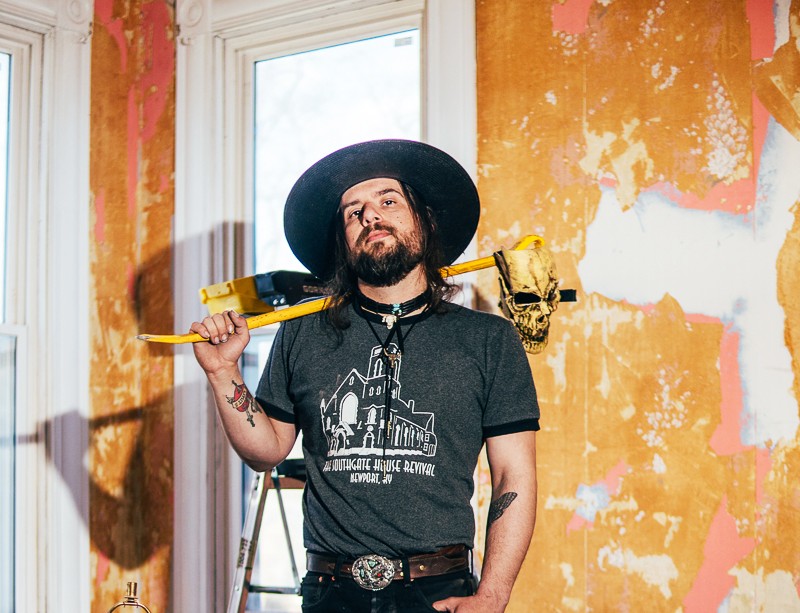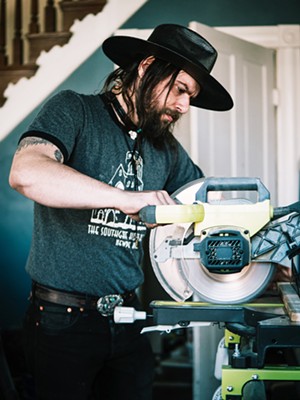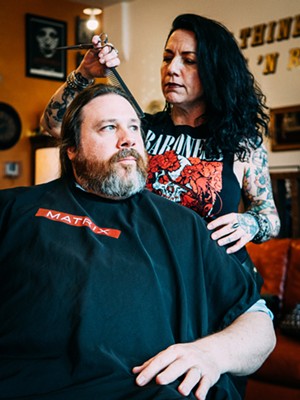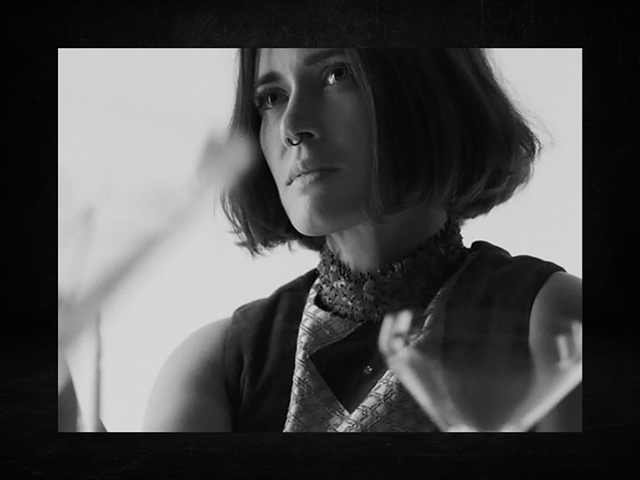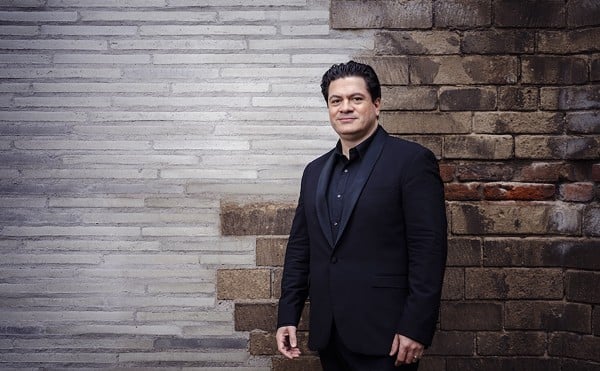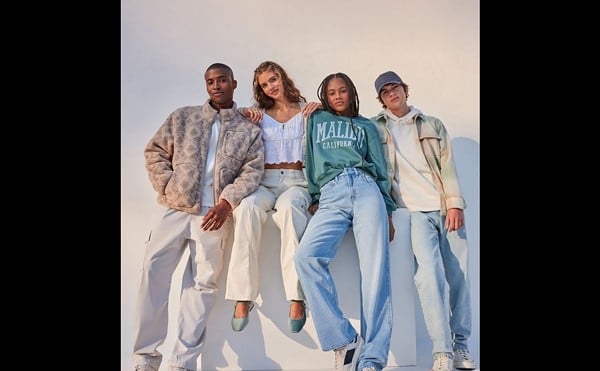This story is featured in CityBeat's March 8 print issue.
To an outsider, the life of a musician can often appear glamorous and a little cryptic. From the subtle, mysterious singer-songwriter strumming a tune on stage while hiding behind a mess of hair and cigarette smoke to the bombastic life and times of a rock and roll god midway through a worldwide tour, the profession has maintained a hold on public consciousness for as long as artists have been paid to perform music. For the non-musically inclined, even the very concept of being able to write and perform a song in front of people is esoteric enough to inspire awe.
But what do the performers really do when they step off the stage or out of the recording studio? For many local musicians, they transition into an entirely different career to fund their musical dreams or wind down with a hobby that’s just as exciting as life in the limelight.
To find out what their secret lives are really like, CityBeat spoke with five Cincinnati musicians whose careers and interests are just as fascinating, surprising and impactful as the effort they put into their songs.
The new American Gothic
Dead Man String Band’s Rob McAllister knows a thing or two about eye-catching aesthetics. The alt-country, one-man band can often be found onstage wearing patched and frayed pants, a worn denim vest, and his eponymous dead skin mask. But over the past 10 months, the firebrand musician has stepped back from the mic to begin refurbishing his house and has gained a newfound personal stability along the way.
Dead Man String Band has gone through many revisions over the years. What once was a one-man act featuring provocative lyrics and gritty guitar has transitioned to a singer-songwriter version (sans mask), then to a trio and then to a five-piece before returning to a solo project.
McAllister says he’s been on quite a personal journey, as well. Much like his mask-wearing stage persona, McAllister has been an incendiary force who often draws attention to himself, but not always in the ways he’d prefer. His bombastic performances and creepy-but-mesmerizing visual presentation contrasted with mid-set outbursts, forgotten lyrics and gear breakdowns. But over the past few years, McAllister says he’s reassessed his life, realigned his priorities, sobered up and focused on his latest goal: home life.
“Well, I'm a lot calmer and less hungover,” McAllister tells CityBeat. “I got sober – officially, July 10, 2020. I've been ‘boring sober.’ I only smoke cigarettes; that's my only vice. That's the last thing I got. I feel like I need that one, though.”
Aside from the mental and physical health benefits of sobriety, McAllister says he had another great incentive to clean up his act – to become the best version of himself for his fiancé, Jen. “At the beginning of 2020, I reconnected with Jen,” McAllister says. “We've known each other for 10 years, and when I first met her, you know the scene in Wayne's World when he sees Cassandra and “Dream Weaver” starts playing? It was that, but then I was told I couldn't hit on her, so I didn't for a decade.”
McAllister recalls when he finally decided to shoot his shot.
“It was like in high school. I'm 34, and I was like, ‘Do you like me?’ And she said, ‘You can cut the shit, I like you.’ And it kind of just went from there,” McCallister says. “It’ll be three years in March, and it doesn't feel like it. We got engaged in November [2022].”
After his fiancé moved from West Virginia to Cincinnati in November of 2021, the couple began searching for their first home in an unforgiving market.
“We started house hunting, and it was insanity. We couldn't go look at a place without it being gone before we got there or just being the most marked up,” McAllister remembers.
The couple found a home but knew from the outset that it would require some renovation to bring it into a liveable state and make it truly their own space. They fell in love with its charm and history, but those were covered up by decades of shoddy upkeep.
“This house was the only house I came back from where I wasn't like, ‘Hell yeah!’ or ‘Hell no!’ I just went, ‘Eh,’” McAllister says. “The rest of the house had been landlord’ed to death. These are the original, 1800’s pine floors, and they were solid-ass white. Everything was beige and white.”
With the purchase finalized last May, McAllister set to work updating the home from the studs out and developed the many skills necessary for the project (“I couldn't change a light bulb pre-2020,” he says). He adds that when a friend noticed all of the long hours, late nights and innumerable swear words that he had poured into the projects, they remarked that he must love the home. But that wasn’t exactly McAllister’s motivation, he says.
“I love the girl that loves the house,” McAllister recalls telling the friend, adding that with a supportive partner, he’s been able to maintain more focus both in and out of the mask. “I always joke that I owe her a home. She made me sane again, which was priceless, I suppose. I mean, I'm a loon, but I'm a calm loon. I'm peaceful now.”
McAllister says the renovation has given him “the finger every chance it gets.” But for every structural correction that is required, McAllister says he’s made historical discoveries like the original 1894 wallpaper from Sears that he’s now preserved in a glass display case. The couple also has taken every opportunity to make the historic home their own by restoring the flooring and adding tin tiles to the dining room ceiling. A recording studio is in the planning stages for the second floor, McAllister says.
Juggling newfound sobriety, refurbishing a centuries old home and celebrating his engagement could easily cause Dead Man – both the human being and the artist – to slide backwards towards the self-destruction. But McAllister says the power he’s cultivated within himself and alongside his fiancé has kept him strong.
“I will say, after seven months, if this house hasn't driven me to drink again, I don't think I will,” McAllister declares. “I feel like I have more control over my ego and that it won't run wild on me. I know I have a brake pedal, so now I can drive faster. So, if I need to get crazier now, I think I could without letting it get to my head.”
Rocking new beauty
The question of what exactly constitutes rock and roll has been around for as long as the guitar has been electrified and turned up to an uncomfortable level. The trouble with finding a conclusive definition is largely due to the fact that the style goes well beyond the confines of a genre of music: it’s an aura, an outward presentation, an-easy-to-recognize-but-hard-to-pinpoint swagger.
That’s why any attempt at classifying Tina Sullivan’s Bang Bang Hair Salon in Clifton has to include rock and roll.
Sullivan, vocalist for local blues rockers Phantom Queen, has been in the hair and music worlds for decades, with one leading directly to the other, even from an early age.
“I was doing all these Tears for Fears and Brian Bosworth cuts on all my little friends before I ever even went to hair school,” Sullivan tells CityBeat. “I was always just kind of a natural and then I got recruited to go to hair school.”
Sullivan went through beauty school and eventually became an instructor before working for chain salons to “learn how to run a shop on their dime,” as she puts it. In 2011, she decided to step out on her own and opened the first Bang Bang Hair Salon, a five-seat setup on McMillan Street in Clifton [the location closed in 2020]. She says the salon nailed her desired vibe right off the bat.
“I started working with the music community, because number one, I figured who around town usually looks cool and rock and roll, and badass, and who usually doesn't have money to afford haircuts? So I started giving away free haircuts for musicians,” Sullivan says. “I didn't want to be your typical kind of salon where you go in and everything's quiet and you're listening to Enya. I wanted to be rock and roll.”
She says the state of the salon’s building also contributed to the atmosphere.
“The reason the aesthetic actually came off the way it did is really funny. The building was in such disarray, in such bad shape, and the landlord would never do anything to fix anything. So I was like, ‘Well, we're going to make it look really fucking punk rock in here,’ Sullivan says. “So we did. We put stickers on everything. We painted it black. We just made it look like we tried to make it look wrecked.”
Sullivan expanded the Bang Bang footprint in 2017 by opening a location on Short Vine Street, crafting what she calls a glam rock yin to the former McMillan location’s punk rock yang. Instead of the stickers and black walls the original location had, Short Vine featured gilded mirrors, overstuffed couches and curios of all kinds.
“When the new salon came along and it was all fancy, I was able to put more of my vintage stuff into it and be a little bit more aesthetically pleasing,” Sullivan says.
Recently, Sullivan has turned her love of antiquing and all things vintage into yet another business venture by selling her collected pieces in Flamingo Haven Antique Mall in Northside, with pieces soon to be sold in Bang Bang itself. She says she’s curated her collection through years of accumulation.
“People always ask me, ‘How did you do the décor [in the salon]? Where do you get your things?’ Most of it comes from my house. This is how I decorate my home. I just switch things around,” Sullivan says. “I love to thrift shop, I love vintage shopping and I always have,” Sullivan says.
For many people, selling a collection of a literal lifetime might be hard, but Sullivan says she sees it as an opportunity not only to make some extra money, but also to better her life.
“I hate to see nobody enjoy it, you know? And I've already had this, I've already loved it, it's been amazing,” Sullivan states. “I've already worn these things, some of my rock and roll clothes, my stage clothes, my corsets and things like that. I really enjoy the process of letting things go.
“It's a good, karmic way to be. You can't get new, good things if you're holding onto your old, good things,” she adds.
Ready for combat
A person watching one of Austin Wolfe’s shows might assume he’s really, really into swords – and they wouldn’t be wrong.
As the vocalist and bassist for local metal act Siegelord, Wolfe dons skull-adorned armor to shout out the fantastical tales of three warriors adrift in a hostile world and the gods they believe will help get them home. This epic story is paired with driving guitar blasts that have all the subtlety of a warhammer blow to the head. Even Wolfe’s stage name Ulfr would be right at home in Conan the Barbarian.
While Wolfe’s love of arms and armor will make sense to anyone familiar with his work in Siegelord, the extent at which he celebrates that love is what is liable to catch fans off guard. Some people might be satisfied with a drunken purchase of a Renaissance faire sword that would inevitably be shoved into a closet, but not Wolfe. Instead, he says he decided to start living his fantasies by joining War Horse Events, a local armored combat group.
“The type of armored combat that we do is called Buhurt, and the sport gets its name because it's derived from an old French word that translates to ‘wallop.’ And that's pretty much what we do – we just wallop each other,” Wolf explains.
Buhurt does go beyond simply walloping an opponent, however. It’s a full-armor, full-contact combat sport in which the weapons, the armor and their impacts are all real. While Buhurt slowly is gaining more mainstream exposure, it is still an obscure sport overall. Wolfe says his interest in it grew naturally through prior activities.
“It's kind of like starting a band,” Wolfe says. “I've always had an interest in fantasy and medieval history and super nerdy stuff. So you spend time just cruising around on Facebook and Instagram, and you start following these dudes out in Europe that are blacksmiths and they make armor and show it off. And then you see some guys in a tournament in Spain just beating the hell out of each other.
“Actually getting involved with it, it's just knowing the right people at the right time,” he continues. “The captain of the team that I'm affiliated with is a friend that I've had for a couple of years but was just casually introduced to through another friend of mine. It's just this domino effect of knowing the right nerds that are highly motivated.”
An interest in fantasy and a group of like-minded individuals can only get you so far in Buhurt. Being willing to step into the ring in 100-pound, full-plate armor with a dulled weapon in hand across from an opponent who is equally equipped takes a special kind of mindset. For Wolfe, it’s one that took time – and a few stiff shots – to cultivate. He tells CityBeat that during his first practice, the team put him into armor and verified that the gear was placed correctly and safely. After that, Wolfe entered the ring with a sparring partner for his first 60-second round.
“They gave me real hits and they just wanted to see how I would react. Do I keep my cool? Can I breathe? Can I hold my balance? Do I make an attempt to strike back? Can I track my opponent?” Wolfe recalls.
Being in real armored combat comes with challenges beyond medieval weaponry being swung at your vital regions, Wolfe says.
“It took me a second to kind of get my bearings [in the ring], just because it is disorienting,” Wolfe says. “With the helmets, there is very poor oxygen saturation; you're breathing hot, moist air the whole time, and you have to over time get control over your adrenaline. Otherwise, you can freak out or panic under the helmet as a first-timer.”
Duels generally follow standard MMA rules and scoring, with points being awarded for fair strikes, time in control, and dominance of the fight. Buhurt teams also take part in melees, typically in three-on-three or five-on-five last-man-standing battles in which technique takes a backseat to instinct. Defeated fighters also stay in the ring for the duration of the round, leading to bodies littering the battlefield during fights where peripheral vision within the helmets is negligible at best.
With a sport this physically demanding and mentally exhausting, participants need equally weighty reasons to keep participants coming back, as the fantasies of being a great warrior can clash with the reality of a gauntleted fist punching into unyielding steel. For Wolfe, both Buhurt and its community have an appeal.
“There is definitely something to be said about the body high that comes with extreme bursts of energy once you pull that helmet off. The first breath that you take, it feels amazing, especially on a crisp, fall morning. It's like breathing in magic,” Wolfe says.
“There's also a huge sense of community. You forge new relationships – pun intended on the forging. And there's also a bit of a rockstar feel to it. Even if you get your ass kicked in the ring, when you go out, people want to take pictures with you,” Wolfe continues. “They think it's cool. People eat that stuff up, especially kids. They want to come up and touch your armor and see if it's real, they want to hold the helmet and take a picture with the knight. It definitely speaks to your inner five-year-old. What I keep telling people is, ‘What kid doesn't want to grow up to be a knight?’”
Mixing up a business
Local music and bars go together like tequila shots and a lime wedge. In much the same way, musicians and bartending gigs are a perfect pair, with nightlife hours and flexible schedules making it easier to balance out live shows and practices.
It makes sense, then, that local musicians Maya Banatwala (vocals and ukulele for Heavy Hinges) and Kristen Kreft (vocals and guitar for The Perfect Children) have partnered together to combine their mutual love for cocktails and music through their joint book series Rocktails: An Amped Up Spin on Mixology. As a company, Rocktails has produced two books, a partnership with Hard Rock Casino Cincinnati, multiple pop-ups and bar takeovers, infusions, and consulting services. The concept grew roots in 2011 when Banatwala and Kreft began working together at Japp’s Since 1879, the center of Cincinnati’s expansive cocktail scene.
“Kris and I worked together side by side at Japp’s for five years, and we always said we wanted to write a book honoring musicians through mixology,” Banatwala recalls.
Banatwala and Kreft left Japp’s in 2017 to pursue their dream but faced an immediate hurdle: how could they write a book about crafting cocktails without access to a bar and the tools found within? Their solution involved partnering with local bars to host events in which the duo could simultaneously perfect their recipes and spread the Rocktails name across town.
“We start doing pop ups at the Listing Loon [currently known as the Loon], at other places, and basically just booking bands and musicians and creating cocktail menus inspired by their work,” Banatwala says.
“We had this idea to write cocktail books based on musicians, but the only way, as two people who don't own a bar or an events company, [we] could possibly do that is to have access to a bar so that we can make these cocktails and take pictures of them,” Kreft adds. “It really kind of stemmed from, ‘Well, we're doing a cocktail book, we've got to have pictures of these beautiful cocktails.’”
The partners began hosting pop-up bar takeovers in 2017 and self-published their first book, Rocktails: An Amped Up Spin on Mixology, the following year Their second book, Cincinnati Rocktails, was released in 2018 in an accelerated writing process fueled by an eager Banatwala telling an interviewer the volume would be ready quickly.
“We had started it, but we had not in any way, shape, or form written this book,” Kreft remembers. “And so, we wrote that one in a year, as well.”
Banatwala and Kreft say the book releases gave them even more momentum to pursue other projects, including a set of music-inspired cocktail infusion kits and a collaboration with Hard Rock Casino Cincinnati, where the partners designed the cocktails menus for several of the casino’s restaurants and bars.

Banatwala and Kreft’s love for cocktailing is evident, but their respective contributions to the Cincinnati music scene can’t be denied either. Banatwala and Kreft each have years of experience with multiple bands, albums and awards to their names, so the marriage of music and mixology was a natural fit, they say. Moreover, both have backgrounds in education; Banatwala tutored students through Finneytown High School’s programs and in different nonprofit organizations, while Kreft was an instructor at School of Rock Cincinnati and developed movement and drama curricula for after-school programs.
“I'm just a big supporter of all things music in Cincinnati, and we love mixology. We thought this would be a really cool way to educate everybody,” Banatwala says. “And we come from teaching backgrounds as well, so this touches on all the areas of our life: being musicians and mixologists and teachers. We just wanted to add author onto it, as well.”
Banatwala and Kreft say that being active musicians has its benefits, especially when it comes time to collaborate with venues to plan their pop ups and bar takeovers. There sometimes are unique challenges to overcome, they say, such as ensuring that the bar has the required ingredients and the staff is prepared to create the cocktails to spec. It can be a more in-depth process than carrying an amp onstage, plugging in and rocking out.
“Our biggest challenge is how many people are going to be there because when you're playing the show, you can play the same show to one person that you will play to 500 people,” Kreft says. “However, if 500 people show up to an event where you need to have cocktails and books, you need enough for 500 people. The brain boggles.”
In a short period of time, Banatwala and Kreft have been able to naturally grow their brand via nimble business decisions, creative problem solving, a mutual passion for music and mixology, and – most importantly – really tasty beverages. But they’re just getting started, they say.
“The cool thing about making these cocktails that are inspired by music is just the creativity involved, and I think that's the most fun for us. That's the part where we're reaching our stride,” Kreft says.
Coming soon: CityBeat Daily newsletter. We’ll send you a handful of interesting Cincinnati stories every morning. Subscribe now to not miss a thing.
Follow us: Google News | NewsBreak | Reddit | Instagram | Facebook | Twitter

